News
Top 7 Cryptocurrency Trends (2024 & 2025)

You may also like:
The past year has been a wild ride in the cryptocurrency space.
Once ripe with fraud and falling prices, the crypto market surged has surged back in 2024.
The cryptocurrency market is currently at a $2.66 trillion market cap, not far off its record high in 2021.
In this report, we’ll share the biggest trends driving the bull market and inspiring investors.
Plus, we’ll discuss the regulations and environmental concerns that could shake the market in the near future.
Here are the crypto trends happening right now and those that are likely to continue through 2025 and beyond.
1. Bull Market Emerges After Approval of ETFs
The value of Bitcoin surged 150% coming into 2024.
And many believe this bull run could last well into 2025.
The price of Bitcoin began 2024 at about $44,000 but had grown to nearly $70,000 by late May.
In one survey crypto experts said that Bitcoin could hit $77,000 by the end of 2024 and $123,000 by the end of 2025.
The survey respondents predicted a huge surge in Bitcoin’s value between 2025-2030.
There are two major factors influencing the bull market: the approval of spot ETFs and the upcoming halving event.
Brokerages began designing Bitcoin ETFs as early as 2013, but the spot ETF wasn’t approved by the SEC until January 2024.
These funds consist of crypto that’s purchased by the financial firm and then offered as shares to investors. The investors never actually hold any Bitcoin, but the ETF tracks with Bitcoin’s market value.
Demand for crypto has gone up, in part, because these ETFs allow investors to hold a low-cost investment in Bitcoin without operating in a crypto exchange.
This makes crypto more enticing for retail investors but also for wealth management advisors who run 401ks or IRAs.
BlackRock and Fidelity have emerged as the early leaders in the Bitcoin ETF market—Blackrock holds $15 billion in Bitcoin assets and Fidelity has $9 billion.
The Bitcoin halving event is the other factor driving up interest in crypto at the moment.

Search interest in “Bitcoin halving” jumped in 2020 in the midst of the last event and is increasing dramatically in the lead-up to the next event.
Halving occurs roughly every four years.
The last one happened in April 2024.
On the halving event day, the reward for mining Bitcoin is cut in half. This decreases the rate at which new Bitcoin is mined.
Many analysts say that this dip in supply will increase demand.
Previous halving events have been followed by an eventual increase in Bitcoin’s price. However, the increase was not immediate and couldn’t be definitively attributed to the halving.
In the six months following the last two halvings, there were gains of 51% (in 2016) and 83% (in 2020).
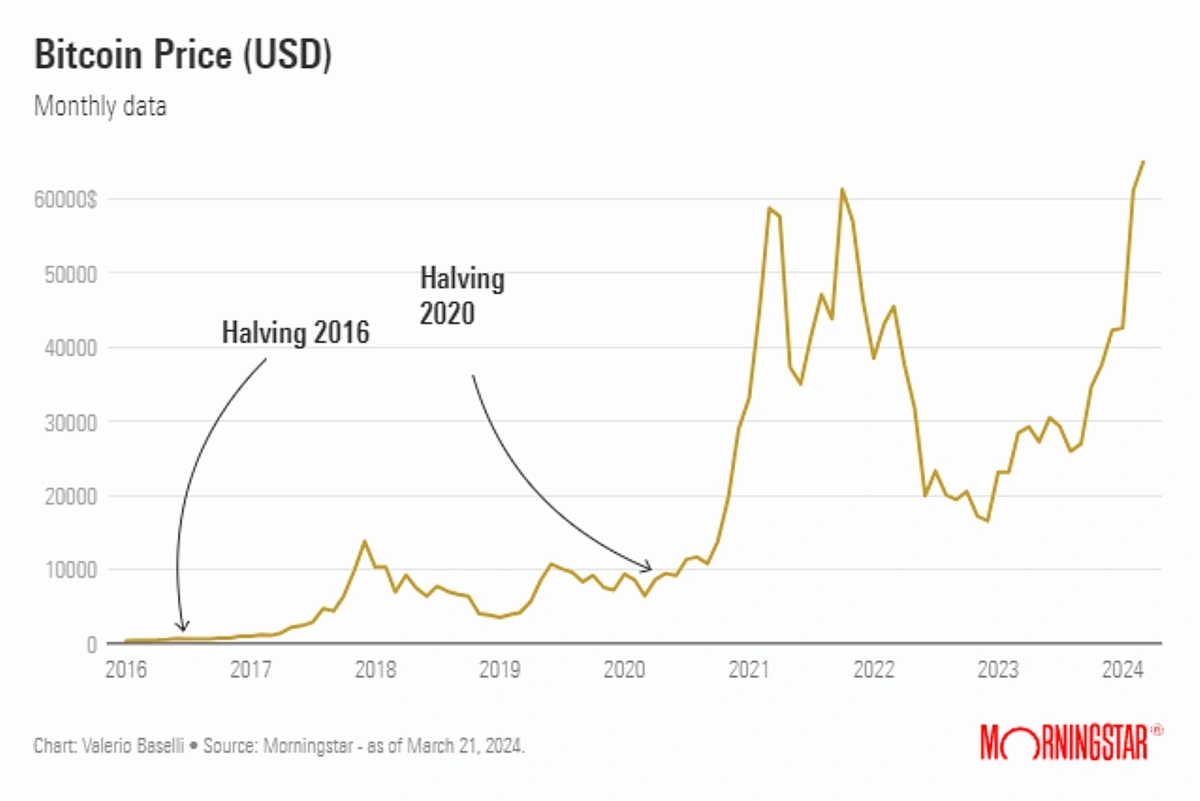
The previous two halving events positively impacted the value of Bitcoin.
In one survey, nearly half of crypto experts predicted that gains after the April halving event will peak in the same manner, at the six-month mark.
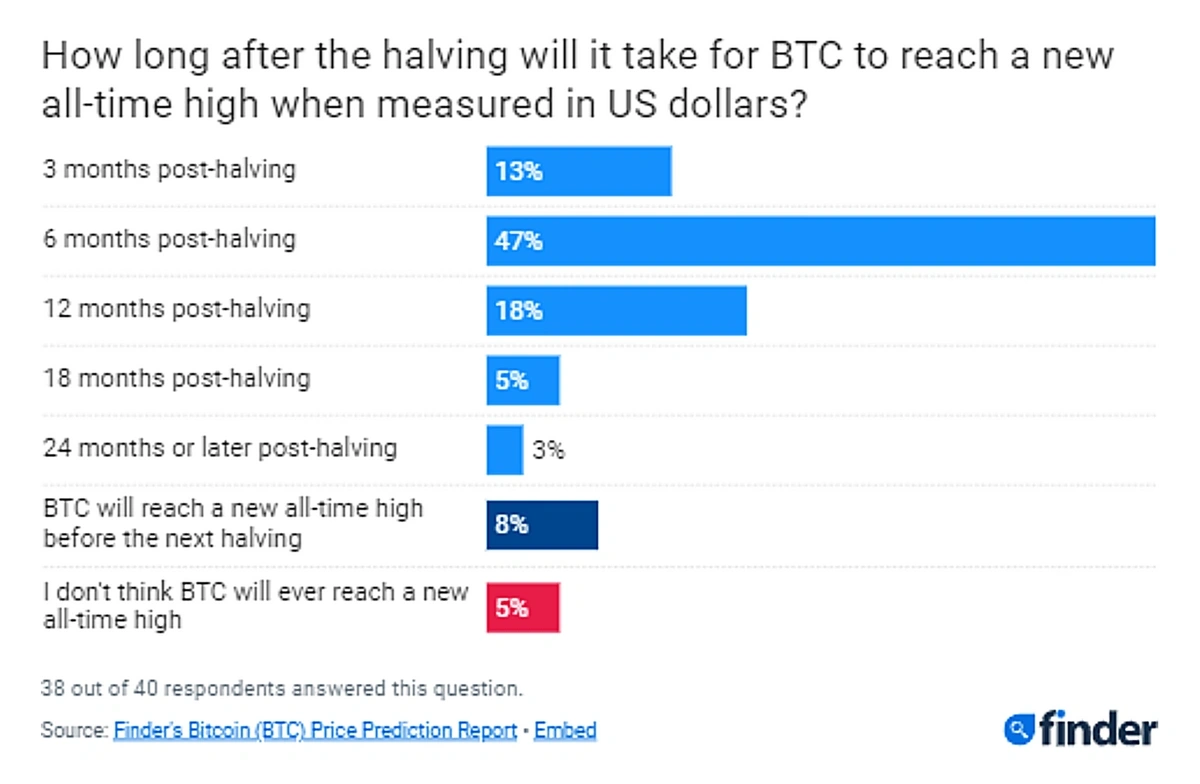
Nearly 50% of crypto experts say Bitcoin will surpass its all-time high within six months of the halving event.
2. The Intersection of AI and Crypto
In recent months, AI has been working its way into the world of cryptocurrency.
AI tokens are cryptocurrencies that are directly related to an AI venture.
Just to name a few examples, AI tokens could be involved in blockchain protocols, decentralized web platforms, and decentralized machine learning platforms.

Search volume for “AI tokens” has grown exponentially in 2024.
And the AI tokens can serve a variety of functions.
Users can use the tokens to pay for services or access data on the platform, and the platform can use the tokens as rewards to pay users.
These tokens can also be used to provide the holders with some level of governance rights.
There are nearly 90 AI tokens in the crypto space right now.
In April 2023, the combined market value of AI tokens was just $2.7 billion.
Now it’s surpassed $39 billion.
Fetch.ai is one of the most well-known AI tokens.
Between mid-February and mid-March 2024, the value of its token (FET) increased 329%.
The platform made headlines in late March when it merged its AI token with tokens from SingularityNET and Ocean Protocol.
The merge formed a new token: ASI (artificial superintelligence)

The “Superintelligence Alliance” came together with the goal of advancing decentralized AI.
The alliance between these three companies is aimed at developing a decentralized approach to AI as opposed to AI protocols and platforms that are dominated by large tech companies.
3. Funding, Mergers, and Acquisitions in the Crypto Market
2022 was a year of crypto bankruptcies.
But in late 2023, investor confidence returned.
In the final quarter of 2023, investors put $1.9 billion into crypto-related companies.
The year’s largest investment, valued at $225 million, went to Wormhole. The company has developed a cross-chain connectivity platform.

Wormhole specializes in interoperability between blockchain platforms.
Fast forward to February 2024 when a total of $485 million of VC funding was invested in blockchain startups.
That represented a three-month high.
Investors say funding in the next year will be focused on real-world applications of blockchain and the infrastructure needed to implement these applications.
When it comes to established crypto companies, the big winners appear to be Bitcoin miners.
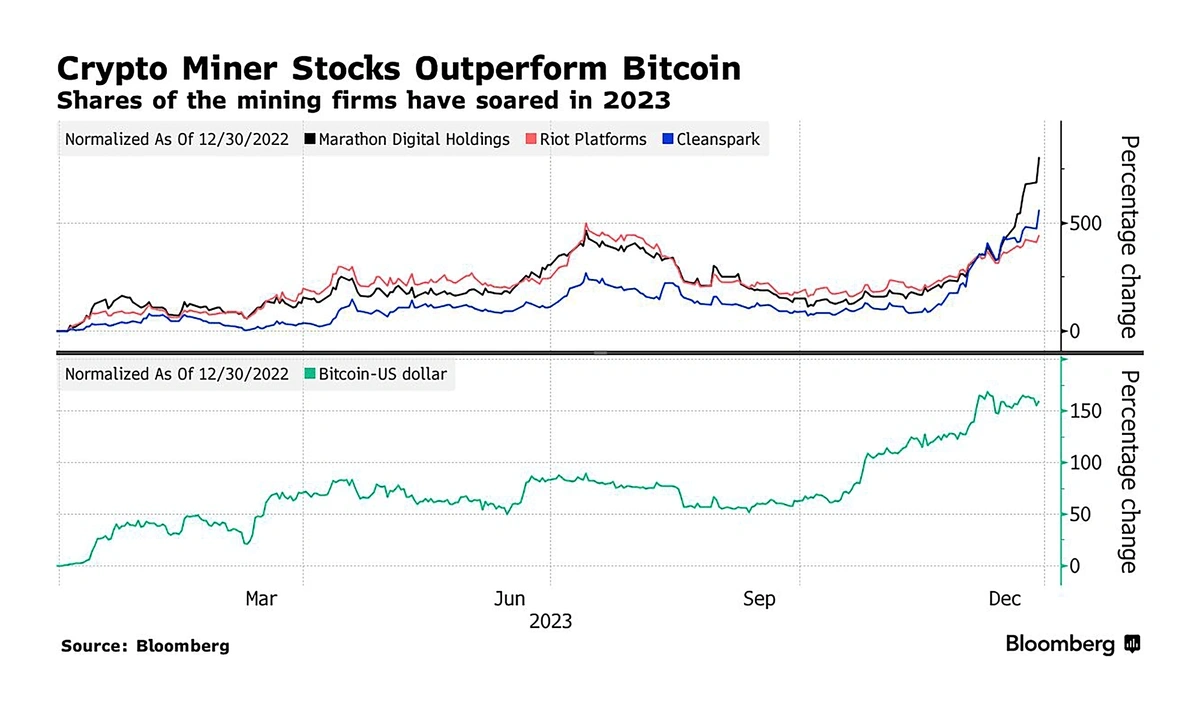
The stock value of some mining firms has grown more than the value of Bitcoin itself.
Marathon Digital stock was up 590%.
CleanSpark was up 440%.
Riot Platforms was up 350%.
As the halving date approaches, industry insiders predict smaller, less efficient mining operations will be acquired by these giants.
In February 2024, CleanSpark announced it would take over three mining facilities in Mississippi in a $19.8-million deal.

Search volume for “CleanSpark” is up 625% in the past two years.
In a merger of equals, Hut 8 Mining and US Bitcoin Corp. merged in November 2023.
The new Hut 8 Corp. now has a $1.14 billion market cap.
4. Increasing Regulation of Cryptocurrency and Exchanges
The crypto meltdowns of FTX and others put a direct spotlight on the regulation of the industry.
And, in fact, there wasn’t much regulation at the time.

Search volume for “crypto regulation” is up 104% in recent years.
However, government entities now seem to be making up for lost time and are primed for enforcement.
The SEC is the nation’s most active regulatory body in the crypto market.
Gary Gensler, the head of the SEC, has been vocal about his support for more regulation in the crypto market, saying it is “rife with fraud and manipulation.”
The stance of the SEC is that crypto is a security, functioning much like a stock. That means crypto firms are required to register with the SEC and follow the organization’s disclosure requirements.
But this guidance is really the only one on the books and there are virtually no other government entities creating laws or regulations for crypto.
And many crypto supporters say the regulations aren’t clear.
Still, although other countries have regulations written in law, the United States is the only country to actively enforce regulations against crypto giants.
In June 2023, the SEC sued Coinbase for not registering as a broker.

The SEC charged Coinbase in June 2023.
The SEC also sued Binance that month, accusing the crypto exchange of mishandling customer funds.
The company was ordered to pay $4 billion in fines in late 2023.
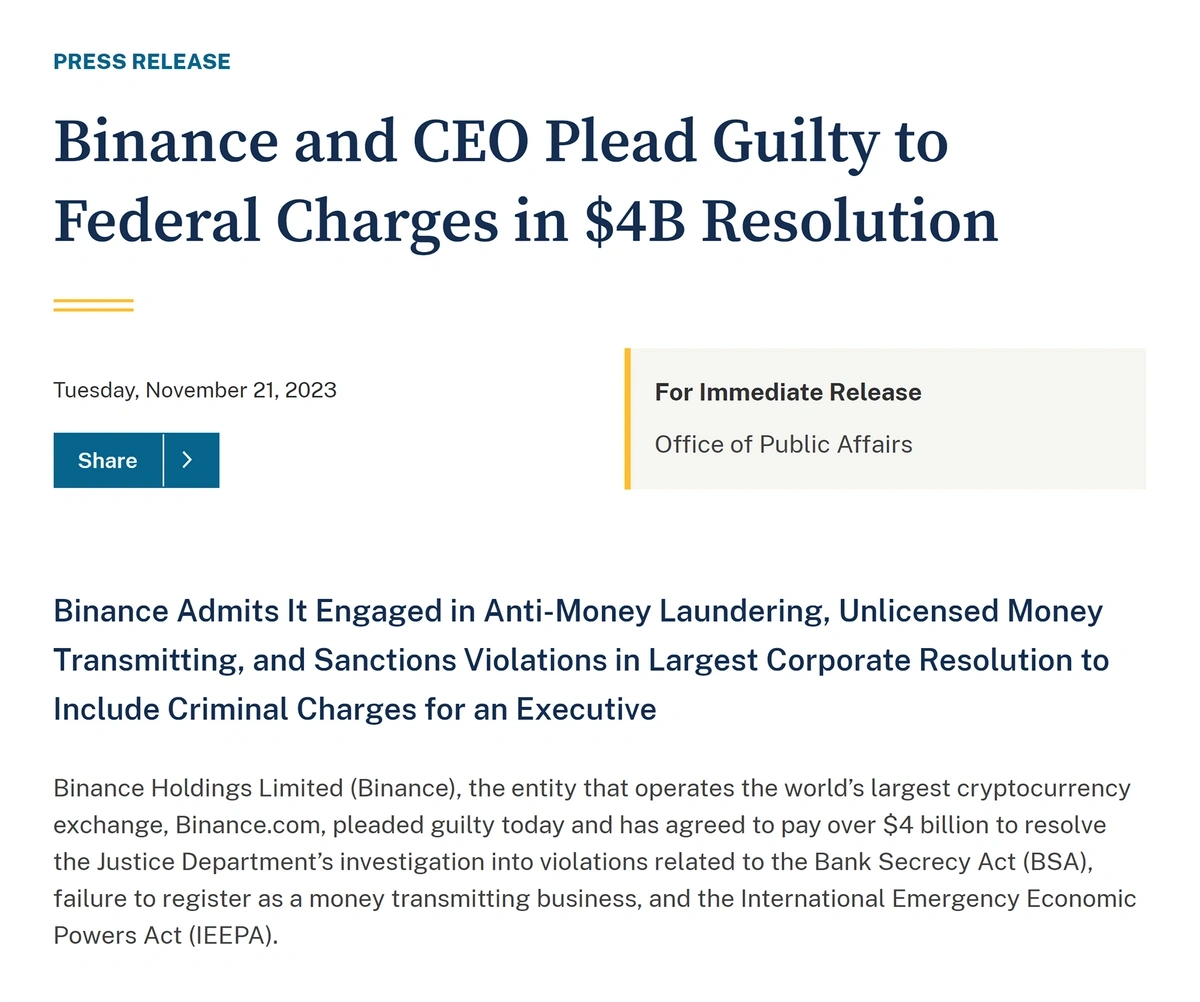
Binance was charged and ordered to pay $4 billion in financial penalties.
In all, the SEC sued five crypto companies in 2023.
Some indirect regulations are also coming from The White House.
President Biden has pushed for a 30% tax on cryptocurrency mining.
As the U.S. government moves toward increasing regulatory scrutiny, some crypto companies are exploring options in other countries.

The fight between regulators and crypto companies is motivating some of the companies to look at options abroad.
Nearly 80% of the crypto exchanges registered in the U.S. are also operating in at least one other country.
There are several recent examples.
Gemini is looking to make moves in the United Arab Emirates.
Coinbase opened operations in Bermuda.
Both cited regulatory concerns as a prime motivator for launching non-U.S. operations.
5. Crypto’s Growing Climate Impact
A lesser-known but potentially pressing trend for the crypto industry is the sector’s energy and climate change implications.
The environmental problems lie within a step of the cryptocurrency mining process called proof of work.
This is a process that requires miners to solve complex mathematical problems via high levels of computing power before they can submit new blocks to the network.
This high-level computing requires an extraordinary amount of energy and water.
According to the Cambridge Bitcoin Electricity Consumption Index, the production of the cryptocurrency uses about 1174 TWh of electricity per year—more than the total annual electricity usage of the Netherlands.
Put another way, a single transaction of Bitcoin uses the same amount of energy as an average US household for nearly 26 days.
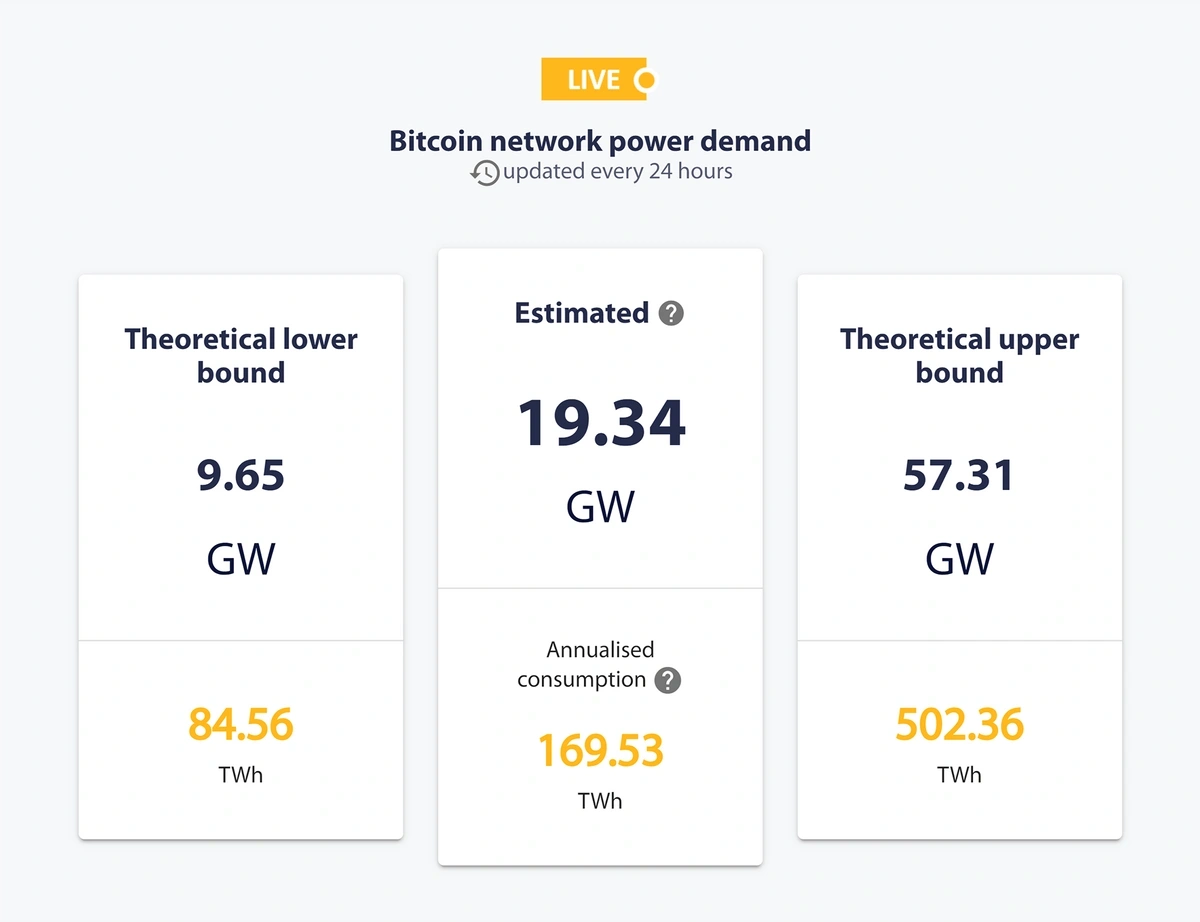
Crypto mining is an energy-intensive process.
In addition, United Nations scientists found that 67% of the energy used in crypto mining comes from fossil fuels.
They reported that the carbon emissions from crypto mining alone could push the world beyond climate goals made in the Paris Agreement.
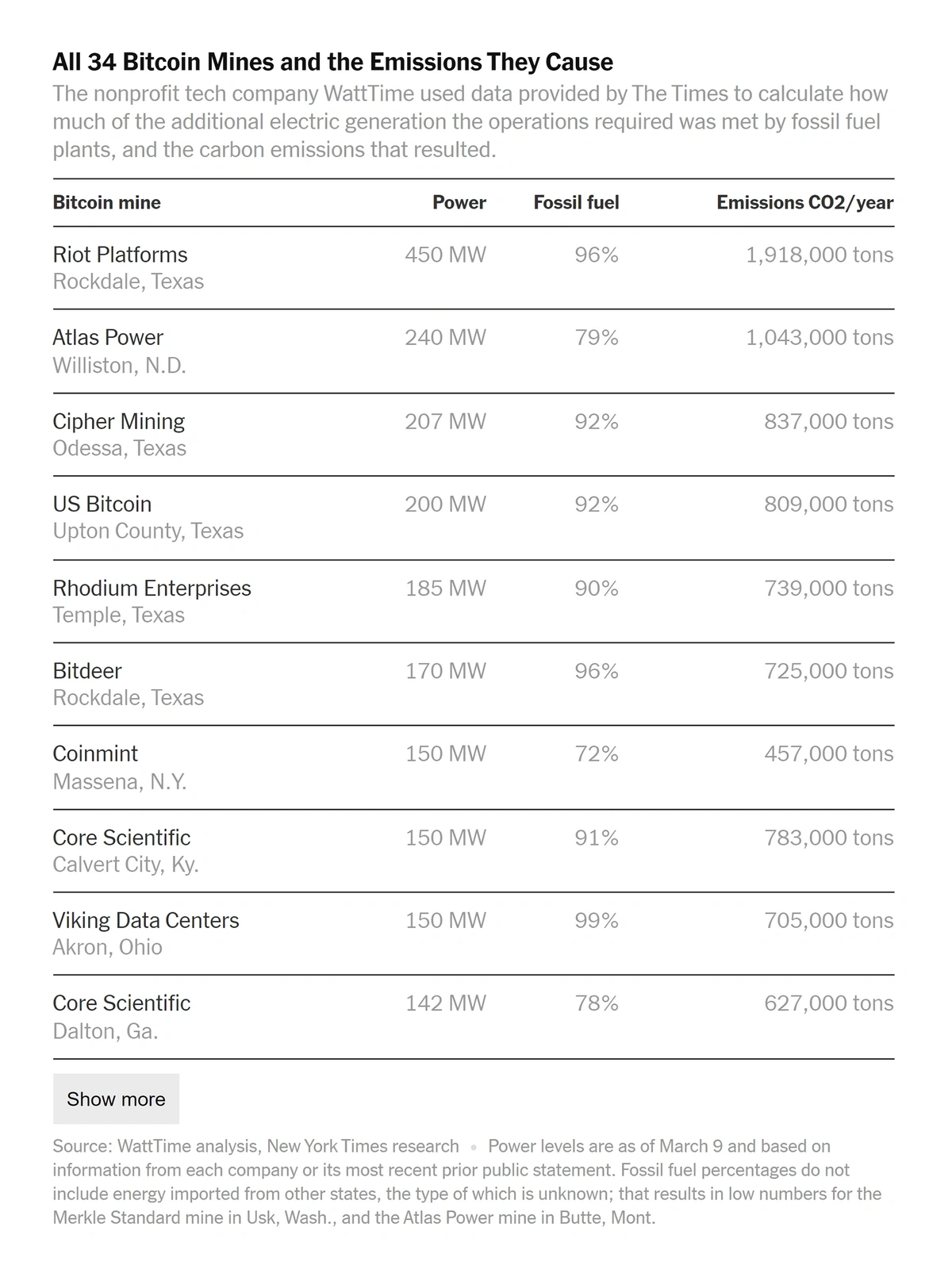
Riot Platform’s mining operation is the largest in the United States.
And it’s not just electricity.
Mining crypto also requires an abundance of water.
In addition to being used for electricity generation, water is used to cool the computer systems and provide the right level of humidity for the machines.
One study found that Bitcoin’s annual water consumption could be as high as 2,237 GL (gigaliters).
That’s equal to the annual amount of water usage in Washington D.C.
In an effort to address climate concerns, Ethereum launched The Merge in 2022, a software upgrade that cut miners’ energy use by 99%.
The upgrade got rid of proof of work and replaced it with proof of stake, a verification method that utilizes cryptocurrency holdings.
However, Bitcoin will likely never switch to a proof-of-stake model.
6. Real-World Assets Turn Digital with Blockchain Technology
Asset tokenization is another trend that takes advantage of the technology behind crypto: blockchain.

Search volume for “tokenized assets” since 2019.
When a real-world asset (RWA) is tokenized that means there’s a digital representation of it on the blockchain.
Tokens can represent all kinds of assets like real estate, art, bonds, intellectual property, and more.
Tokenization can enable the automation of specific actions regarding the asset, provide traceability, enable fractional ownership, and increase liquidity—just to name a few benefits.
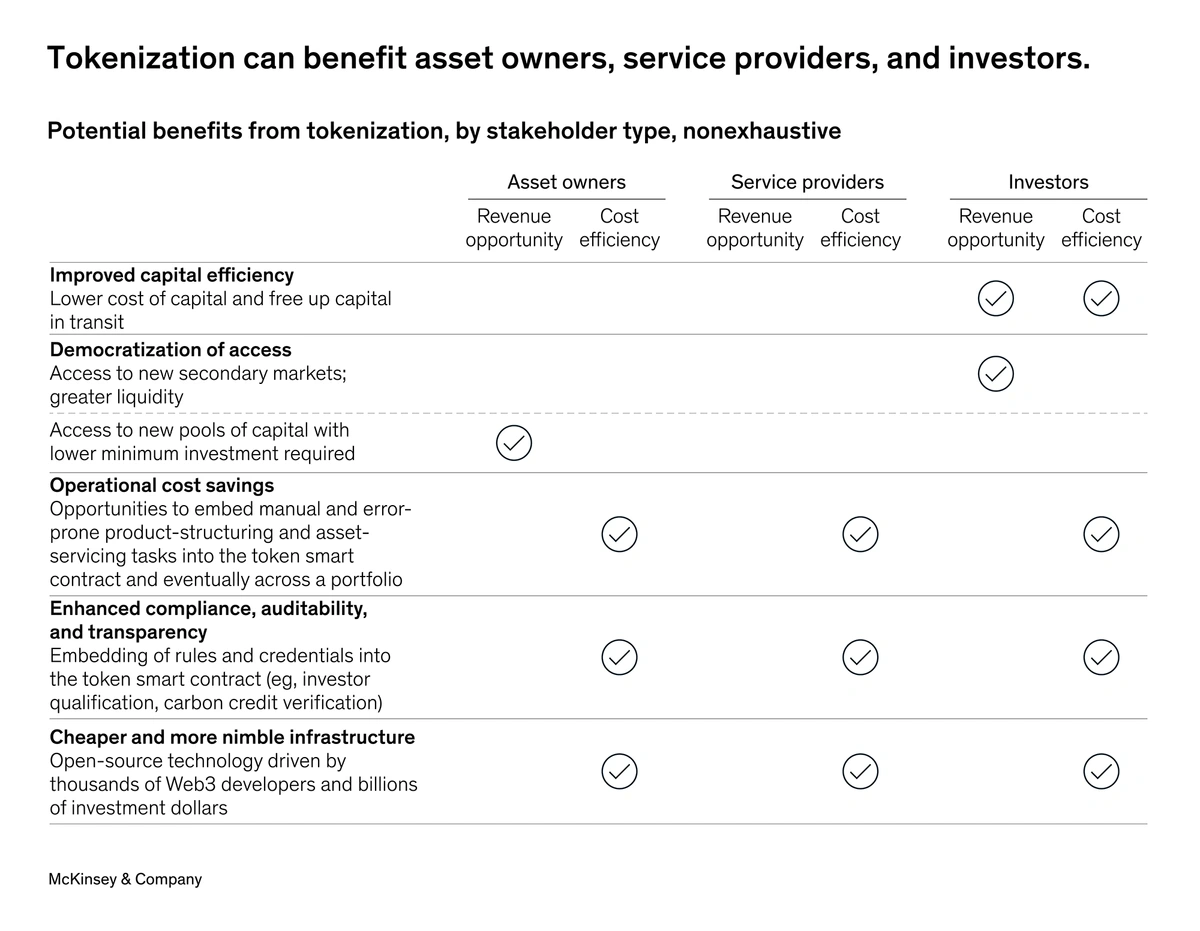
Tokenizing an asset enables a host of benefits.
Financial institutions are taking an interest in tokenization.
BlackRock launched its first tokenized asset fund, called BUIDL, in 2024.
The fund utilizes the Ethereum blockchain.
Securitize, a firm specializing in digital asset tokenization, has partnered with BlackRock on the fund.
In its first week, the fund brought in $240 million.
Citigroup is also testing the tokenization of financial assets on a private blockchain.
The bank has said that this will enable clients to transfer their assets on a 24/7 basis and cut processing times down to mere minutes.
Predictions show that there’s a growing interest in tokenization of assets.
The market was valued at $2.81 billion in 2023 but could reach $9.82 billion by 2030, hitting a CAGR of nearly 20%.
Predictions from Boston Consulting Group are even more optimistic.
Analysts say that up to $16 trillion worth of real-world assets could be tokenized by 2030.
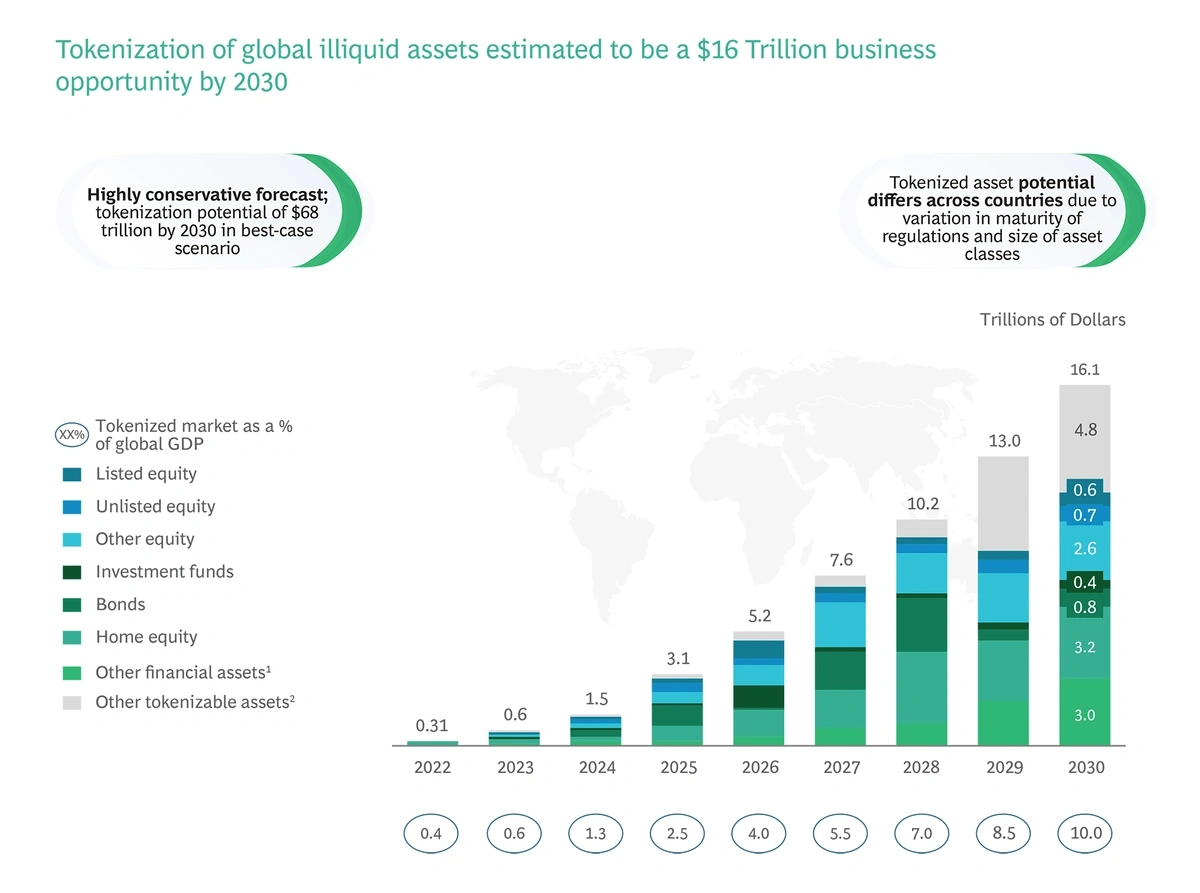
Tokenized assets could represent 10% of global GDP by 2030.
7. Global Officials Explore Central Bank Digital Currency (CBDC)
Banking systems across the world are in the process of developing their own digital currency, referred to as Central Bank Digital Currency (CBDC).

Search volume for “CBDC” over the last 5 years.
According to the Brookings Institution, this would create a virtual currency that is centralized and managed by central banks as opposed to decentralized blockchains.
There is hope that this type of currency would offer the benefits of crypto without the risk.
Digital currencies are currently being developed or tested in 132 countries, which amounts to 98% of the world’s GDP.
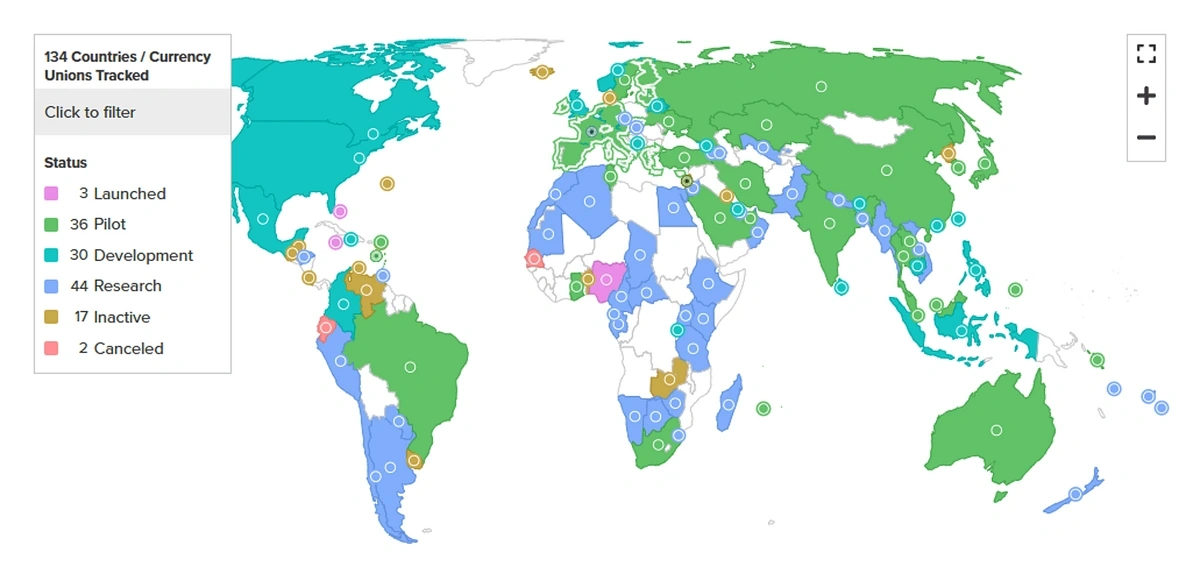
Many countries in Europe are piloting CBDCs.
CBDCs are already fully operational in Jamaica, Nigeria, and the Bahamas.
China is piloting the largest CBDC trial in the world.
The digital yuan, called e-CNY, is being tested in 260 million wallets across 25 cities.
By 2030, the Bank of International Settlements says 15 retail CBDCs (those used by consumers and businesses) and 9 wholesale CBDCs (those used by banks) will be operational.
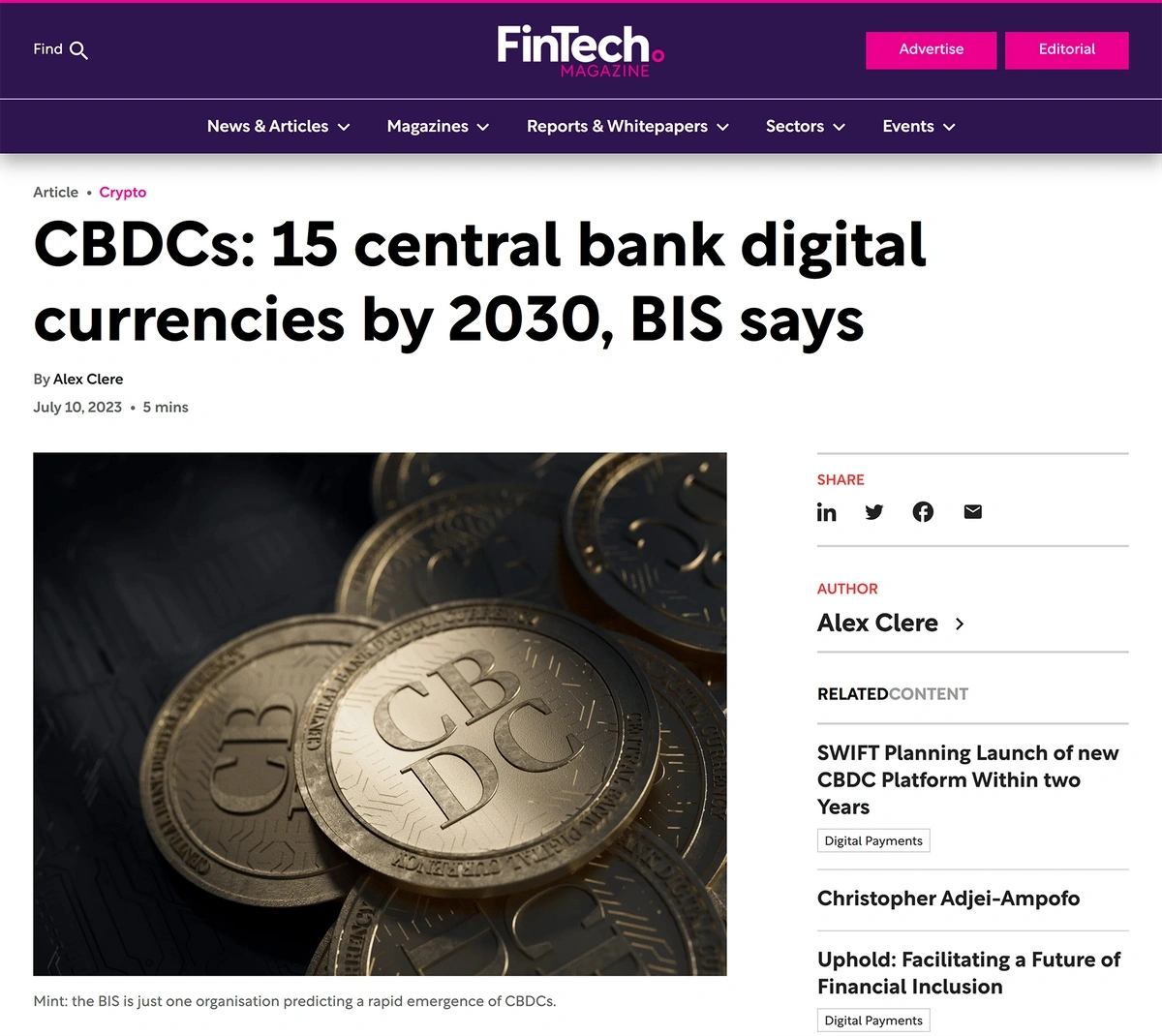
The Bank for International Settlements says that more CBDCs are coming soon.
To connect various CBDC, the bank messaging network SWIFT is planning to launch a network of CBDC platforms in the next year or two.
The goal of the network is to enable the cross-border use of various CBDCs and enable banks to continue to use their existing infrastructure to manage transactions.
The organization has already tested its network with 38 banks and financial platforms.
Despite growing global interest, officials in the United States say they have no plans to develop CBDC.

The Fed has said that any CBDC would be subject to congressional approval.
U.S. consumers have been vocal about their privacy concerns regarding CBDC.
In addition, bank officials worry that digital currency could negatively impact the cost and availability of credit, set up commercial banks for possible failure, and decrease the stability of the financial system as a whole.
Conclusion
That concludes our list of the top seven crypto trends to watch right now.
The cryptocurrency market has been almost completely unpredictable over the last several years. The bull market has been in control for the past few months, giving investors and crypto enthusiasts hope for a record-setting future.
But with increasing regulation and climate impacts, it seems nearly inevitable that crypto’s future will be just as uncertain as its past.
News
US Cryptocurrency Rules Delayed by ‘Never-Ending’ Lawsuits

Ripple CEO says cryptocurrency industry still seeking regulatory clarity from US
Speaking to Bloomberg News on Wednesday (July 17), Author: Brad Garlinghouse he said America is behind behind other countries which have already adopted cryptocurrency regulations.
“What we’re seeing, where it’s the UK, Japan, Singapore… even the European Union, more than two dozen countries have come together to provide a framework for cryptocurrency regulation,” Garlinghouse said.
“It’s frustrating that we as a country can’t get that regulatory framework in place. And instead, we have this never-ending lawsuit coming from the SEC that doesn’t really address the problem.”
Ripple has been the target of some of these legal disputes. Securities and Exchange Commission (SEC) sued the company in 2020, accusing it of conducting a $1.3 billion operation offering of unregistered securities tied to its XRP token.
However, last year a judge ruled that only Ripple’s institutional sales of XRP, not retail sales, violated the law, a decision widely seen as a victory for the cryptocurrency industry.
As PYMNTS noted at the time, that ruling has “far-reaching repercussions impact across the digital asset ecosystem, which has long maintained that its tokens do not represent securities contracts.”
However, Garlinghouse told Bloomberg on Wednesday that the company cannot wage multimillion-dollar legal battles over each token.
He spoke to the news agency from the Republican National Convention in Milwaukee, where the party is backing the candidacies of former President Donald Trump and Ohio Sen. J.D. Vance, both of whom are considered pro-cryptocurrency.
But Garlinghouse argued that cryptocurrencies “should not be a partisan issue,” and noted that he had recently attended a conference in Washington that included Democrats, including White House officials.
“I think they were there, listening to the industry… it was refreshing to start having that conversation,” she said.
President Joe Biden earlier this year he vetoed a measure which would have ended the SEC’s special rules for crypto-asset custodians. This legislation was supported by both the digital asset industry and the banking industry.
Ripple early this year donated $25 million to the cryptocurrency industry’s super PAC Fair Smoothiewith Garlinghouse stating at the time that such donations would continue every year, as long as the industry had its detractors.
Second Open SecretsWhich monitor spending For campaigns, the PAC has spent $13.4 million this year, much of it to help defeat Rep. Katie Porter’s (D-Calif.) U.S. Senate campaign.
News
The Future of Cybersecurity in the Cryptocurrency Industry

The cryptocurrency space has had a tumultuous journey, with its fair share of ups and downs. As we look to the future, one area that remains a constant focus is cybersecurity. The digital nature of cryptocurrencies makes them inherently vulnerable to cyber threats, and as the industry evolves, so does the landscape of potential risks.
In 2022, the cryptocurrency market faced significant challenges, with over $2 trillion in market value lost. This event served as a wake-up call for the industry, highlighting the need for robust cybersecurity measures. The future of cryptocurrency security is expected to see a shift towards more regulated and established institutions taking the reins of crypto technology and blockchain infrastructure.
The decentralized nature of cryptocurrencies offers numerous benefits, such as transparency and financial inclusion. However, it also introduces unique security challenges. The risk landscape is filled with threats such as hacking, phishing, ransomware attacks, malware, and social engineering. These threats not only lead to financial losses, but also damage the reputation and trust within the cryptocurrency ecosystem.
Mini-MBA Tekedia edition 15 ((September 9 – December 7, 2024) started recordings; Register today for discounts reserved for early bird customers.
Tekedia AI in Business Masterclass Opens registrations Here.
Join the Tekedia Capital Syndicate and IInvest in Africa’s best startups Here.
The decentralized nature of cryptocurrencies offers many benefits, but it also presents unique security challenges. Cyber risks such as hacking, phishing, and ransomware pose threats to the integrity of digital assets. The infrastructure that supports cryptocurrencies is not immune to vulnerabilities, including smart contract flaws and exchange hacks.
To address these vulnerabilities, the infrastructure that supports cryptocurrencies must be strengthened. Smart contract vulnerabilities, exchange hacks, wallet breaches, and flaws in the underlying blockchain technology are significant concerns that must be addressed to ensure the security and integrity of digital assets.
As cybercriminal tactics and techniques become more sophisticated, the cryptocurrency industry must stay ahead of the curve. The future will likely see more targeted attacks, exploiting weaknesses in infrastructure, networks, and human factors. This requires a proactive and multifaceted approach to cybersecurity.
To mitigate these risks, several measures must be adopted:
Strengthening security measures: Developers, exchanges, and wallet providers must improve security protocols, use strong encryption, implement multi-factor authentication, and conduct regular security audits.
Education and awareness: Users should be educated on best practices for protecting their digital assets, including using strong passwords, recognizing phishing attempts, and using hardware wallets for secure storage.
Looking ahead, the cryptocurrency industry is expected to see an increased focus on robust security measures. Blockchain projects and exchanges are likely to invest in advanced encryption techniques and decentralized storage solutions to protect user assets. The future impact of cyber risk on cryptocurrencies will depend on the collective efforts of stakeholders to address vulnerabilities and strengthen security measures.
Collective efforts by stakeholders in the cryptocurrency space are crucial to address vulnerabilities and strengthen security measures. While challenges persist, advances in cybersecurity technologies and practices offer hope for a more secure and resilient cryptocurrency ecosystem.
The future of cybersecurity in the cryptocurrency industry depends on finding a balance between innovation and regulation. It requires a collaborative effort from all parties involved, from developers to end users, to create a secure environment that fosters trust and growth in the industry. As we move forward, it is critical that lessons learned from past events guide the development of stronger security measures, ensuring the longevity and stability of cryptocurrencies as a vital part of the modern economic toolkit.
Like this:
Like Loading…
News
Bullish XRP and RLBK price predictions rise, outpacing the broader cryptocurrency market, prompting Shiba Inu holders to switch!

Bitcoin’s one-week surge from $60,000 has pushed other cryptocurrencies into an uptrend. However, for many altcoins, this trend has been temporary. Altcoins such as XRP and Shiba Inu (SHIB) have experienced price drops. However, Rollblock, a new altcoin on the Ethereum blockchain, has thrived during this period, attracting thousands of investors looking for long-term growth.
XRP’s Nearly 30% Growth Over Last Week Drops as Selling Pressure Increases
XRP is seeing further price decline as Ripple investors withdraw their profits from the token. The surge in XRP’s price to $0.64 in the past week has provided investors with a perfect opportunity to increase their returns in the short term. With the ongoing sell-off in XRP, XRP has jumped over 8% in the past day and is now trading at $0.59. However, analysts tracking XRP indicators predict that XRP could still extend its gains by over 30% in the coming weeks.
Shiba Inu (SHIB) marks its third consecutive day of losses
Shiba Inu (SHIB) is in a period of adjustment after a week of strong gains. In the last 24 hours, SHIB has seen a jump of over 7%, reflecting a natural market fluctuation. Analysts are observing a death cross on the Shiba Inu chart, which historically signals the potential for future opportunities as the market stabilizes. As investors explore new possibilities, some are diversifying into promising altcoins like Rollblock (RBLK) to strategically rebalance their portfolios and capitalize on the emerging trend.
Rollblock (RBLK) Up Another 7% as New Investors Join Pre-Sale
Rollblock (RBLK) has taken the cryptocurrency market by storm, having attracted investors from more popular altcoins like Shiba Inu (SHIB) and XRP. Rollblock’s growth is attributed to its utility in the $450 billion global gaming industry.
Rollblock aims to use blockchain technology to bridge the gap between centralized and decentralized gambling. With blockchain technology, Rollblock secures every transaction in its online casino, providing transparency and convenience to millions of players who are uncomfortable placing bets on other iGaming platforms.
This innovative use of blockchain technology in the industry has grown Rollblock to over 4,000 new users in less than two months. With plans to add sports betting, this number is expected to grow exponentially in Q3.
Rollblock uses a revenue sharing model that splits up to 30% of its casino’s weekly profits with token holders. This happens after Rollblock buys back $RBLK from the open market and uses half of it for rewards. The other half is burned to increase the price of $RBLK.
Rollblock price has seen four increases in the past month with $RBLK tokens now selling for $0.017. Analysts predict that at the current growth rate, Rollblock could increase by over 800% before the presale ends. For investors looking for a long-term token with growth potential, phase four is the best time to buy Rollblock before its price skyrockets!
Discover the exciting Rollblock (RBLK) pre-sale opportunities now!
Website:https://Rollblockpresale.io/
Social: https://linktr.ee/Rollblockcasino
No spam, no lies, just insights. You can unsubscribe at any time.
News
Texas Crypto Miners Turn to AI as Crypto Declines

As cryptocurrency mining becomes less profitable, Texas cryptocurrency mining companies are switching to supporting artificial intelligence companies.
Bitcoin miners, with their sprawling data centers and access to significant energy resources, are ideally suited for computationally intensive AI operations, and as cryptocurrency mining becomes less profitable, companies see this shift as a logical answer to their problems.
On Thursday, Houston-based Lancium and Denver-based Crusoe Energy Systems announced a multibillion-dollar deal to build a 200-megawatt data center near the West Texas city of Abilene to support advanced artificial intelligence applications such as medical research and aircraft design, CNBC reported. The plant represents the first phase of a larger 1.2 gigawatt project.
Lancium and Crusoe’s move into AI mirrors a broader trend among bitcoin miners. The combined market capitalization of the top U.S.-listed bitcoin miners hit a record $22.8 billion in June. Companies like Bit Digital and Hut 8 are diversifying into AI, with Bit Digital securing a $92 million annual revenue deal to supply Nvidia GPUs and Hut 8 raising $150 million to expand its AI data center.
But the growing popularity of these operations also presents challenges, particularly for the Texas power grid. Last month, the Electric Reliability Council of Texas announced that the state is expected to nearly double its energy production by 2030 to meet the high energy demands of data centers and cryptocurrency operations.
Lieutenant Governor Dan Patrick expressed concern about the projections.
“Cryptocurrency miners and data centers will account for more than 50% of the additional growth. We need to take a close look at these two sectors,” He wrote on Twitter/X. “They produce very few jobs compared to the incredible demands they place on our network. Cryptocurrency miners could actually make more money selling electricity to the network than they do from their cryptocurrency mining operations.”
Analysts predict significant growth in data center power capacity, which is expected to account for up to 9% of U.S. electricity consumption by 2030.
The operations also pose challenges for nearby cities. Earlier this month, TIME reported that a crypto-mining facility was seriously compromising the health of residents in the city of Granbury. TIME reported more than 40 people with serious health problems, including cardiovascular disease, high blood pressure and hearing loss. At least 10 of the residents needed to go to the emergency room or an urgent care facility.
The disturbances were caused by the extreme noise generated by the crypto-mining facility’s fans, which are used to keep the machines cool. While the proposed data center in Abilene would use liquid cooling systems, it’s still unclear whether the facility’s operations would pose a health risk to local residents.
-

 Nfts1 year ago
Nfts1 year agoShardLab Launches ZK-Based Tool for Digital Identity and NFT Vouchers
-

 News1 year ago
News1 year agoWallet recovery firms are abuzz as stranded cryptocurrency investors panic in the bitcoin boom
-

 Bitcoin1 year ago
Bitcoin1 year agoBitcoin, Ethereum, Solana and Cryptocurrency Markets Look Ready to ‘Send’ as Stars Align, According to Investor Chris Burniske
-

 Altcoins12 months ago
Altcoins12 months agoThree Altcoins Poised for Significant Growth in 2024: ETFS, OP, BLAST
-

 Altcoins12 months ago
Altcoins12 months agoAccumulate these altcoins now for maximum gains
-

 Nfts1 year ago
Nfts1 year agoOG Crypto Artist Trevor Jones Unveils Groundbreaking Collection of Ordinals | NFT CULTURE | NFT News | Web3 Culture
-

 Bitcoin1 year ago
Bitcoin1 year agoBillionaires are selling Nvidia stock and buying an index fund that could rise as much as 5,655%, according to some Wall Street analysts
-

 Videos9 months ago
Videos9 months agoKamala just won the boner! [Bad For Crypto]
-

 Videos1 year ago
Videos1 year agoLIVE FOMC 🚨 Could be CATASTROPHIC for Altcoins!
-

 News1 year ago
News1 year agoA Guide for Newcomers & Beginners – Forbes Advisor
-

 Videos1 year ago
Videos1 year agoAttention: a historically significant BITCOIN signal has just appeared!
-

 Videos1 year ago
Videos1 year agoSTOCK MARKET FUD! ⚠️ [Why This Is GREAT For Bitcoin Traders!]







